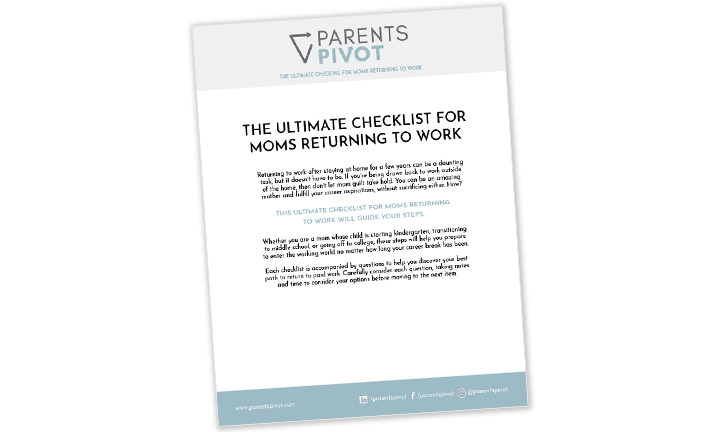Congratulations! If you’re reading this post, it means that you are hoping to return to work after parental leave. That’s a big step and one worth celebrating!
With any transition, you may be excited, nervous, dreading it, and wishing it would get here soon – all at the same time. That’s totally normal. Depending on your company’s maternity and paternity leave policy, you may have been off for six weeks, six months, or something in between. No matter the amount of time you’ve spent solely focused on your little one, there are steps you can take to prepare for the transition back to paid work.
Transition Tips For You
It’s important to understand that you are going to have a harder time than your baby with this big life transition. Your entire life has changed – for the better, of course – but in many ways it’s also more difficult. You are caring for a human that is 100% dependent on you, and that changes your priorities, personally and professionally.
Before you get back to work, consider a couple of internal reflection questions:
Who do you want to be as a parent?
Who do you want to be at work?
How do those two versions of yourself align?
Before I had kids, I never gave a second thought to staying late at work, taking on extra responsibilities, and hopping on a plane with little notice for a big meeting. After kids, I no longer want that lifestyle. I still care deeply about my career, but being at home and having dinner every night with my kids is a top priority. The parent I want to be impacts who I am and what I do at work.
This process isn’t just for parents who have just welcomed their first child. Parents deal with personal and professional transitions after every child. It’s not always easy to accept a new lifestyle, especially if your work has always been your focus. Take the time you need to reflect and create a vision for your new life and family. Be open to the new change – you may love it more than you think!
Transition Tips For Baby
The best thing you can do for your little one is to be patient and understand that getting used to something new takes time. After all, your baby is still getting used to life in general! If your schedule is going to change, try to ease into it as early as possible.
For example, if wake up time is going to have to move up an hour, start moving it up in 5 minute increments a few weeks before you actually have to. That way, by the time your baby needs to get up so you can get to work, they are already a pro!
If your baby will be away from you while you are working, start spending a bit of time away while someone else cares for them so they get used to other people, preferably the person who will be caring for them while you are working.
Practical Considerations For Returning To Work After Parental Leave
There are dozens of practical life adjustments that you’ll need to make when returning to work after parental leave. Here are the considerations we suggest putting at the top of your list:
Determine your work schedule. Set or flexible? Part-time or full-time? What time will you start? What time will you be home? Knowing your schedule will trickle down to every other decision you need to make, so figuring it out first (and early) will set you up for success.
Set your care schedule. After you know your work schedule, it will be easier to figure out your care schedule needs. Full day? Mornings or afternoons? Only certain days of the week?
Start looking for care providers ASAP. With your care schedule in hand, decide the best care provider needs for you and your baby. Facility or In-home daycare? Nanny or part-time sitter? Nanny share or grandparents? The pandemic has made finding child care very difficult, so start looking as early as possible. Many daycares have waitlists and in-home care providers are in high demand, so we can’t say it enough: start early!
Plan your baby feeding strategy. Will you be pumping? If so, when, where, and how? Work & Mother is a great place to pump if your company is part of their network of lactation suites. Milikify is another awesome resource for moms who want to continue breastfeeding while working away from the home. They freeze dry your milk, making it easier to store and use on the go. Homemade baby food or store-bought purees? Setting a feeding strategy now will allow you to focus on giving your baby extra hugs when it’s day 1 of back-to-work.
Set up contingency plans. If there is one universal truth with parenting, it’s this: it’s rare for things to go as planned! What happens when your baby is sick? What happens when your care provider is sick? If your work schedule ever changes, how will your care schedule and provider need to be adjusted? If there is an emergency, what is the process for both you and the care provider? Think through these answers, write them down, and make sure everyone is aware of the plan that needs to be involved. When the time comes for you to use your back up care, it will be ready and you’ll have less worry. Some companies partner with Bright Horizons for back up care options if daycare falls through for the day or a nanny can't make it or if an elder parent needs support.
Set Goals For Your Return To Paid Work
It’s possible to set yourself up for success as you return to work after parental leave! If you need help setting short- and long-term goals, both personally and professionally, Parents Pivot would love to partner with you. We have made it our mission to be the one-stop online shop for all your return-to-work needs, no matter where you are on your journey.









